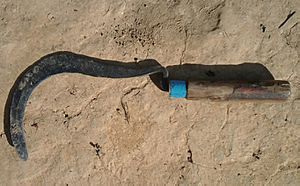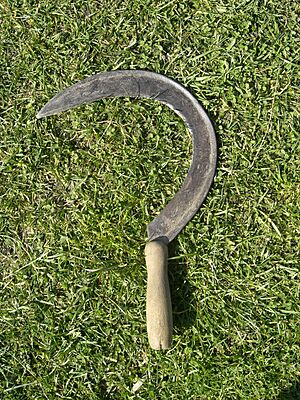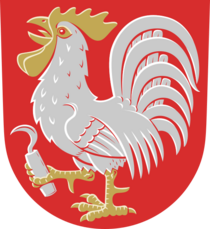Sickle facts for kids

Nepalese sickle from Panchkhal
|
|
| Other names | Bagging hook, reaping-hook |
|---|---|
| Classification | Cutting |
| Related | Scythe |
A sickle is a small, curved hand tool. Farmers use it to cut down crops like grain or grass. It's also called a bagging hook or reaping-hook. The blade is sharp on the inside curve.
People have used sickles for thousands of years. Since the Iron Age, many different types have been made. They were first made of iron, then steel. Sickles can have smooth or jagged (serrated) blades. Both types cut plants, but they work best for different tasks. Serrated blades are still common today, even in big harvesting machines.
Contents
How Farmers Use a Sickle
The sharp, curved part of the sickle cuts plants. Users can pull or swing the blade against the plant stems. The stems get caught in the curve and are sliced. Sometimes, the user holds the plants in one hand. Other times, a stick holds them down.
When cutting wheat, farmers often used a serrated sickle. They would hold the wheat stalks in a bunch. After cutting the wheat heads, the long straw was cut with a scythe. Wheat straw was important for thatching roofs. Oats and barley were usually cut only with a scythe. This is because their straw was softer and used for animal bedding.
Some sickles are made for cutting grass. Their handles are often bent downwards. This helps the blade stay close to the ground. Sickles for cutting grain usually don't have this bend. Grain is not cut as close to the ground. These grain sickles often have jagged edges.
If a sickle is used a lot to cut plants like cereal, its blade gets a special shiny mark. This mark is called "sickle-gloss." It shows where the blade has worn down.
Sickles as Tools and Weapons
Like many farm tools, a sickle can be used for other things. Sometimes, they were used as simple weapons. For example, in Japan, there was a weapon called a kama. It looked like a sickle. People in Malaysia, Indonesia, and the Philippines also used sickles in their fighting styles. In Indonesia, a sickle called a celurit is used by the Madurese people. They use it for both daily tasks and fighting.
Other Interesting Uses
- The hammer and sickle is a famous symbol. It stands for communism. The hammer means factory workers. The sickle means farmers. Together, they show workers and farmers uniting.
- The Grim Reaper is sometimes shown holding a sickle. This is instead of his usual scythe.
- Ancient Druids were said to use golden sickles in their special ceremonies.
- The Hungerford family, a noble family from the Middle Ages, used three sickles as their family symbol.
About the Bagging Hook
A bagging hook is a larger type of sickle. It's also called a reap hook. It usually has a handle that is offset. This means the handle is bent so the user's hands don't hit the ground. The word "bag" or "badge" means to cut grain by hand.
The blade of a bagging hook is heavier than a normal sickle. It always has a smooth, not jagged, edge. It's usually about 40 millimeters (about 1.5 inches) wide. The curved blade is about 45 centimeters (about 18 inches) long.
Bagging hooks became popular in Britain in the mid to late 1800s. Later, machines like the scythe and reaping machine replaced them. However, bagging hooks were still useful when crops were bent over. Machines couldn't cut these crops well without losing grain.
Farmers also used bagging hooks to cut field beans and other plants. These plants were used to feed animals or for bedding.
Sometimes, people confuse the bagging hook with a billhook. A billhook is heavier and straighter. It's used for cutting wood or trimming hedges. While a bagging hook could cut young plants, it wasn't strong enough for woody material.
Images for kids
-
An Ancient Greek iron sickle, found in Athens.
-
A Congolese sickle (left) and a replica throwing knife (right) at the Manchester Museum.
See also
 In Spanish: Hoz (herramienta) para niños
In Spanish: Hoz (herramienta) para niños
- Aruval, an Indian tool similar to a billhook
- Billhook, a tool used for cutting woody stems
- Brush hook
- Kaiser blade or sling blade
- Kama, a Japanese weapon like a sickle
- Machete
- Scythe, a larger tool for cutting grass or grain
- Hammer and sickle, a symbol of communism
- Harpe, an ancient Greek or Roman long sickle
- Khopesh, an ancient Egyptian weapon shaped like a sickle









